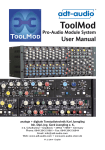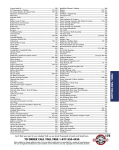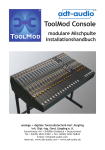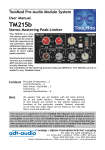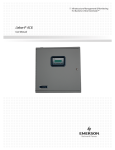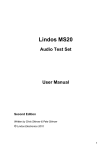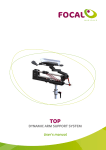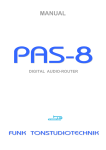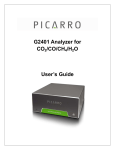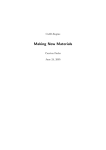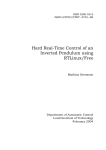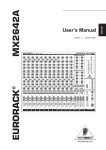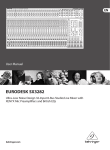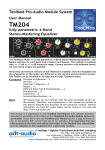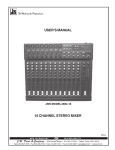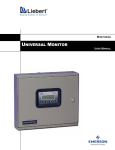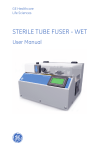Download User Manual TOOLKIT CHANNEL STRIP
Transcript
��������� User Manual ��� � ���� �� ����� TOOLKIT CHANNEL STRIP Version b/2005 • English analoge + digitale Tonstudiotechnik Karl Jüngling • Inh. Dipl.-Ing. Gerd Jüngling Scholtwiese 4-6 • D45966 Gladbeck • Germany • Phone: 0(049) 2043 51061 • Fax: 0(049) 2043 56844 E-Mail: [email protected] • Internet: www.adt-audio.com www.adt-audio.de www.adt-audio.biz ��� � ���� �� ����� ��������� Table of Contents Before you begin Safety Hints ToolKit Overview Mic Preamp Line Input Filters Processing Section Block Diagram Compressor Crest Factor Attack Time Release Time Envelope Soft Knee Auto Gain Gain Gain Reduction Display Side Chain Insert Stereo Coupling Noise-Gate Threshold Attack Time Hold and Release Filters 3 3 4 4 5 5 6 6 7 7 8 8 8 9 9 10 10 10 10 11 12 12 12 12 Key Insert Equalizer Limiter Insert Section Output Section Technical Data Appendix Block Diagram Connectors, general The Toolkit Connectors Ground Lift Power Supply Connections Power Supply Units ToolPwr-M ToolPwr-S ToolPwr-E Current Consumption Mains Power Maintenance Environment Temperature Soiling Cleaning 13 13 15 16 16 17 18 19 20 21 21 22 24 24 24 25 25 26 27 27 27 27 27 This manual contains information about the adt-audio ToolKit Channel Strip that have been carefully checked. In line with a policy of continuous development, information may be changed or updated without notice. adt-audio may also make improvements and/or changes in the products described in this information at any time. Technical data and/or the description of functions are always non binding quotations and no warranted attributes. Product picture may differ from the current version with regards to details and can contain optional equipment, that is not part of the standard scope of supply without express hints. Users are advised to contact adt-audio for personal attention and up to date information for specific products. Creative involvement from human beings also may mean that information on this Web site may contain technical inaccuracies or typographical errors. 2 ��������� ��� � ���� �� ����� This manual contains information about the installation and operation of the ToolKit Channel Strip in rackmounted format. Before you begin: Please check as soon as you get the devices if the cardboard boxes or wooden cases are damaged in any way. If even possible, open the boxes as long as the forwarder is present. If this is not possible ask him for a written confirmation of the damage. All our shipments are insured; however, the insurance will only pay if there is evidence that the damage was caused by the transport. So please: If you can find any damage Get a written confirmation from the forwarder that the delivery was damaged in transit If you neglected to check for damage with the forwarder, look for a witness and make records of time and date, name and address of the witness, and of the facts concerning the damage Make some pictures of the damage before you open the boxes If even possible, open the packing while the forwarder or a witness is present and check if you can find that the devices are also damaged Inform us as soon as possible SAFETY HINTS: IF THE DELIVERY CONTAINS DEVICES THAT HAVE TO BE CONNECTED TO THE MAINS POWER LINE, MAKE SURE THAT YOU FOLLOW THE COMMON SAFETY RULES FOR HIGH VOLTAGE ELECTRIC CIRCUITS. NEVER REMOVE PROTECTION GROUNDS! MAKE SURE THAT ALL CABLES AND SOCKETS ARE IN PROPER STATE AND THAT THE INSTALLATION IS SAFE! IF YOU OPEN A DEVICE, REMOVE THE MAINS POWER FROM THE DEVICE BEFORE YOU OPEN THE CASE. SWITHCING OFF THE DEVICES DOES NOT MEAN THAT THE DEVICE IS HARMLESS. DO NOT MAKE ANY MODIFICATIONS INSIDE THE DEVICES – YOUR LIFE IS IN DANGER! DEVICES MAY HAVE SHARP EDGES THAT MIGHT HURT YOU – MAKE SURE THAT YOU HANDLE WITH CARE WHILE YOU INSTALL THE DEVICES. OPEN A DEVICE ONLY IF WE HAVE EXPRESSLY AGREED THAT YOU DO SO. YOU WILL LOOSE YOUR WARRANTY IF YOU MAKE UNAUTHORIZED MODIFICATIONS OF THE DEVICES. 3 ��������� ��� � ���� �� ����� The complete Input Channel Strip ToolKit The complete Input Channel Strip Toolkit combines an extensive assortment of high quality input amplifiers and processing stages in a unique way. The channel strip contains: an excellent Transformer Mic Preamp and an additional Line input amp, a versatile compressor with crest, envelope, soft knee, side-chain insert and auto gain that is not limited to only one sound an ultra fast noise-gate with a complete set of controls, separate, wide-range high-pass and low-pass filters and key insert, the sophisticated adt-audio 5 band equalizer with 3 fully parametric ‘Vienna Bridge’ based bands, silky sounding HI EQ and soft bell low EQ, all bands with +/-20 dB boost/cut range a super fast brick-wall limiter, a sweeped 24 dB/oct. high-pass and a 12 dB /oct low-pass filter, a balanced, switched, insert, a second output with level control, extensive internal routing system to place the compressor, noise-gate and insert pre or post the EQ The sonic quality of the pristine but warm transformer balanced mic preamp, + 30 dBu headroom throughout the entire device, the versatile compressor that can handle all kinds of signals, the famous adt-audio EQ that is used with the channels of the large format production consoles and the complete feature set, all add together make the ToolKit Channel Strip a perfect device for the mixing engineer who has all the tools in a 1U high box. Additional versatility was added to allow external keying of the noise-gate and side chain processing of the compressor. The switched, buffered insert section than can be routed pre or post EQ, gate and dynamics allows insertion of any additional processing device the user might with to use in combination with the ToolKit channel strip. The Mic Preamp The mic preamp and the line preamp are totally separate amplifiers, each with its own gain control. The microphone input is transformer balanced and floating. The oversized input transformer, brand Haufe, Germany, in combination with a instrumentation amplifier offer a pristine but warm sound performance, a maximum gain of 70 dB and a headroom of + 30 dBu at the output. The ultra low noise input stage has a noise figure of less than 1.3 dB @ 70 dB gain that remains below 2 dB down to less than 40 dB gain, which is actually more important than the noise performance with very high gain setting, since in most cases a gain setting in the range of 40 dB or less is necessary. The noise figure is the distance between the noise of the 200 ohms source resistor and the input 4 ��������� ��� � ���� �� ����� referred noise of the preamp. In difference to all other noise measurement methods, this value offers a clear picture of the real noise performance. A noise figure of 0 dB would mean that the preamp is noise free. The gain control range is 25 dB to 70 dB. The PAD switch inserts a 25 dB attenuation pre the input transformers that makes possible to use the microphone input with high-level signals. The input impedance is 2 kohms without pad and 3 kohms with pad. The P48 switch activates the phantom power supply. The Toolkit mic preamp is used with almost all input modules of adt-audio‘s large format consoles. Very well balanced RF filtering maintains a bandwidth of more than 100 kHz with a very flat phase response. The frequency response is better than +/- 0.2 dB in the range between 30 Hz and 20 kHz with all gain settings. The very important low frequency phase shift is less than 10 ° with gains up to 70 dB even though a soft subsonic filter protects the entire signal from intermodulation by subsonic interference. The ToolKit mic preamp has a bandwidth of more than 100 kHz. Internal RF filters suppress high frequency interference above 100 kHz in a well-balanced way that maintains the phase response of the high audio frequencies but rejects RF interference that can cause intermodulation distortion effectively. The common mode rejection of the input is better than 70 dB @ 15 kHz and better than 90 dB at and below 1 kHz. The oversized input transformer keeps low frequency distortion caused by saturation of the transformer‘s core very low. The Line Input The LINE input is totally separated. A relay that cuts off the line input if it is not selected maintains very high crosstalk values also with very high gain settings of the mic preamp. The input is electronically balanced. The CMRR is internally trimmed and better than 80 dB from 20 Hz to 1kHz and better than 70 dB @ 15 kHz. The input impedance is higher than 10 kohms in the frequency band from 20 Hz to 20 kHz. The line input can handle levels of more than + 30 dBu. The gain control of the line input has a control range of +/- 20 dB. The center detent is trimmed to 0 dB +/- 0.2 dB. At 0 dB the noise of the line amplifier is better than - 98 dBA / - 94 dBu. With + 20 dB gain, the noise value is still better than - 90 dBA. The frequency response from line input to output is better than +/- 0.2 dB from 20 Hz to 20 kHz. The line bandwidth is 160 kHz. In the audio band, the phase response is better than + 5/-10°. A Phase reverse switch allows to invert the mic and line input signal. In addition, a peak present level indicator with a multi color LED displays the level at the output of the input amplifiers. This LED is green if the level is higher than - 20 dB. A level of 0 dB changes the color to yellow. Increasing the level above 0 dB changes the color via orange to red. With red color, the headroom is still approximately 5 dB. This principle allows a very effective way to control the level with only one LED. The Filters The Filter section is fed from the input amplifier. It is inserted into the signal chain by the FILT switch. The high-pass filter has a sweep range from less than 20 Hz to 600 Hz and a slope steepness of 24 dB/oct. The sweep range of the low pass filter is from > 20 kHz to 1.5 kHz. The slope steepness of the low-pass filter is 12 dB/oct. The frequencies are calibrated to the -3 dB point. Both filter are ‚maximum flat‘ active RC filters that are well balanced for best possible phase response. 5 ��� � ���� �� ����� ��������� ��� ���� ��� ���� �� ����� ���� ���� ��� ������ ��� ��� ���� ����� �������� ���� ����� ���� � ��� � ���� ���� ��� ���� ��� ��������� ���� � ��������� ��������������������� �������� ���������������������� ��������� ����� �������� � ����� ��� ���� �������� � ������ �������� ���� ������� �������� ���� �� ���� The Processing Section The processing section of the ToolKit Channel Strip contains Compressor, Noise-gate, Equalizer, Insert and Limiter. All stages or totally independent audio building blocks that are optimized for the particular purpose. We mean by that, that compressor, noisegate and limiter have their own VCA‘s, their own audio input and output and their own control voltage generation. The Toolkit does not used dynamic processors that use the same audio path for more than one function like a compressor-limiter or a compressor-noisegate does. All combined dynamic units cannot offer the best possible performance for a particular purpose, since it is always a compromise between the different functions. ���� ���� �� ������� ��������� ��� �� ���� ����� ����� ��� ����� ���� �������� ����� ����� ���������� ��� �������� �������� ���������� ���������� ������ ��� ������ ��� ��� ��� ���� ��� ������ ��� ���� ��� �������� ��� ��������� ���������������������� �������� ����������������������� ���� ����� ������ ��� ���� ����� ������ �� ��� ������ �� ��� ������ ��� ���������� ����� ������� Compressor, noise-gate and insert can be routed pre and post the equalizer. Please, see the block diagram for details. With no POST and PRE switch pressed, the processing stages are connected in this way: Compressor - Noise-Gate - Equalizer - Insert - Limiter ������ �� ������ ��� ������� ������� ����� ���������� ������ This extensive principle offers many advantages. The input of the gate is fed by the output of the compressor, which means, that the signal that is already compressed, controls the gate with a constant level. In addition, the gate, when it is left in the normal configuration post compressor, also rejects the noise that increases as soon as the signal level drops and the compressor drives up the gain. The limiter that is always installed pre the output driver, controls the real output level and not an undetermined level that results from the settings of the compressor. ������ The Compressor and the Noise-Gate have POST switches that insert the particular processor post equalizer. With both POST switches pressed, the stages are 6 ��������� ��� � ���� �� ����� arranged in this way: Equalizer - Compressor - Noise-Gate - Insert - Limiter The PRE switch of the insert section routs the entire section from post EQ, pre Limiter to post Filters. These three switches offer the choice of 7 different arrangements of the processing stages. It is also possible to reverse compressor and noise gate independently by an external connection of the side-chain insert and the key insert. If the side chain insert output is connected by a short TRS cable with the key input, the key switch of the gate can be used to control compressor and gate differently. The key switch routs the input of the gate‘s control chain to the side-chain insert output of the compressor that is fed from the compressor‘s input. This means that the gate is now controlled by the uncompressed signal. This additional function works with all possible settings of the POST switches but NOT if the compressor is post while the gate is still pre EQ. In this case, the gate is controlled by its own output signal, which means that it is permanently closed since there is NEVER a control signal that can open the gate. Please consider this effect if you use this trick to enlarge the routing possibilities of the device. The yellow line on the picture shows the necessary connection to accomplish this function. The Compressor Just like the mic preamp, the compressor of the Toolkit channel strip has a history of two decades. It was originally developed as dynamic section of the MAGNUM V1 large format production console in 1986. After several upgrades and it was used with the MAGNUM V2. The actual versions of the MR5 music production console use this compressor as well as the MAGNUM V3 console. The last fine-tuning was made with the development of the Toolkit channel strip. The Toolkit Compressor is a feed forward controlled system that uses a high performance VCA, brand THAT to control the level of the audio path. The character of the rectifier that is actually an RMS converter that is combined with a very fast peak detection circuit can be modified by the 3-position CREST switch. In position 1 it works as a fast peak detector while position 4 selects a moderate RMS conversion. Position 2 selects a well-selected compromise between the two worlds and offers a characteristic of the rectifier that avoids the disadvantages of both pure principles. Actually, setting two selects a very fast RMS conversion that, on our opinion, is the best choice for many applications that require dynamic treatment. With appropriate settings of the time controls, threshold, ratio, and knee, it is possible to add more than 10 dB of loudness without an increase in level and without negative side effects. The compressed signal is just louder but sounds still natural The ‚standard‘ controls, Threshold, Ratio, Attack, and Release have more than sufficient control ranges to make any setting possible. The regulation charateristics are optimized with the ‚12 o‘clock‘ principle, which means, that you have a good basic setting if you start with all pots set to the center position, before 7 ��������� ��� � ���� �� ����� you start optimizing the setting for the particular program material. The range of the threshold is from + 18 dB to -32 dB; the 0 dB posittion is internally calibrated. The ratio control covers the entire range from 1:1, which actually means, that the compressor is off to 20:1, which is limit operation. The setting of the Attack Time is very important, since it determines the sound performance of the unit more than anything else. Of course, we assume that you already have appropriate settings of the other controls before you start to figure out what you can do with the attack control. The range is from 0.1 ms, which is very fast, to 30 ms, which actually means that the reaction time of the compressor is so slow that there is no compression of transients anymore. The range from approximately 0.5 ms to 8 ms is mostly used with real setting. Leaving the other controls unchanged, different attack times in that range will modify the tonal result a lot, when the release time is fast enough. If Crest is switched to RMS Mode, the minimum attack time is determined by the integration time and not by the setting of the attack pot alone. With Crest 4, setting the attack time all the left results in an attack time of approx. 1 ms. The Release control determines the compromise between fast recovery of the level and low frequency distortion that is the biggest problem of any analogue compression. The distortion of low frequency signals under regulation is not a problem of a particular device but the principle. The wavelength of low frequencies is in the range of the necessary release time that is mainly determined by the release time of the human ear. The human ear recovers after 0.3 seconds, which means that we are not able to hear a regulation that is faster than this time. You can try this easily. Set the release time of a compressor to a time of more than two seconds and compress a percussive signal like a kick drum. You will hear the compressor ‚pumping up‘ after each beat. Now lower the release time since you don‘t hear the pumping anymore and check the setting of the release control. You will end in the range of 0.3 seconds. If not, check the release scale of your compressor. To be honest, most of the scales are nothing but phantasy with many devices. Anyway, let‘s dig a little deeper. If we compress a signal with a base frequency of 60 Hz (our kick drum), the period time of this base frequency is 16 ms. If the gain reduction was 10 dB and the release characteristic is a standard discharge curve, the gain change is going to be several dB‘s within the period of the 60 Hz signal. This means, that we do not control the level only. We also modify the waveform since our gain change is too fast for this period time. Distortion is just another term for the modification of the wave form. So any compression of bass signals ends up in a compromise between pumping and distortion. The control range of the ToolKit compressor‘s relase time is from 50 ms to 3s. Of course, you will get a totally distorted signal if you set the release that fast, but if you compress a signal that does not contain low frequencies, you can really use such a fast setting. This is the case with many vocals or instruments. However, if you want to be on the save side as far as the release time is concerned, start with a setting of 0.6 seconds. The Envelope control is a useful helper to find a better solution for the distortion - release time compromise. The Toolkit compressor has a three-position switch. Envelope does two things at a time. The release time is modified by the frequency of the input signal in a way, that a high level, low frequency signal increases the release time for a very short time. This part of the entire function works just as you would manually increase the release time a little as soon as a low frequency signal is treated. Of course, it is not possible to do this manually. You will always be too slow and too late. However, the envelope system does not have such problems. In addition there is a filter stage in the side chain that reduces the low frequency range in a special way that is not a simple high-pass filter but a frequency response that is optimized for this pur8 ��� � ���� �� ����� ��������� The Soft Knee pot changes the ratio around the threshold point. Setting this control all to the left disables the soft knee function. With this setting, the transition from the unregulated state with levels below threshold to the regulated state above threshold is hard. Increasing the setting of the knee control makes this transition smoother. Actually, a setting all to the right expands the transition range to 6 dB. Within this range, there is a smooth transition from the linear part of the curve to the compression rate that is determined by the ratio control. Actually, the soft knee does not modify the sound performance of the compressor considerably but it makes possible to increase the compression by several db‘s. There is no general rule for the use of this feature. It just depends on the program material, the setting of the other controls and your desired result if the knee function is more or less useful. ������� � ������� ����� ���� ���� ��������������� �� �������� ����� � �� ����� ���� � � � ���� ��� � �� ���� ��� �� �� ��� ����� �� �� �� � ������ ����� ���� pose. This combination results in a much better treatment of bass signals. Position 1 and 2 of the envelope switch determines different amounts of release modifications and low frequency reduction. �� �� ����� ����� ���� Auto gain As soon as you change any setting of the compressor, the output level will be changed. More ratio or a lower threshold setting increases the gain reduction and reduces the output level. A longer attack time delays the gain reduction and results in more peaks and therefore in a higher output level. So the gain needs to be readjusted all the time you modify a setting. Apart from this tiresome work there is the problem that you cannot easily compare different settings, since the influence of the different levels is often higher than the result of the different setting of the compressor. Working like this is not very pleasant. A way out is the Auto gain system. It is based on the idea, that a feed-forward controlled compressor system produces a gain reduction that can be calculated and therefore compensated. It works like this; setting the threshold to -10 dB and the ratio to 2:1 reduces the level above threshold to half the dB value. In clearer words, an input signal of 0 dB with threshold at -10 dB and ratio 2:1 causes 5 dB of gain reduction and the output signal is -5 dB. The auto gain circuit must add this 5 dB of gain to compensate the loss of this setting. Sounds simple, but, like always, there are some problems that have to be considered. Problem no. 1 is quite easy. If the input signal is a lot higher than 0 dB, auto gain should not bring up this level again. Doing this would not be a real problem with small ratio settings; however limiting a signal would not be possible anymore. The solution is simple. Auto gain starts working only below 0 dB threshold. Any higher setting brings the level down and leaves the gain reduction unchanged. Problem two is not so simple to solve. The above calculation is only correct if the attack time is really fast, which means that the output has no unregulated peaks that increase the level above the calculated value. However, this is not the case with real compressor settings. Just the settings with longer attack times produce the best tonal results. Therefore, it makes no sense to ignore this problem and leave it as it is or reduce the auto gain in a way that it roughly fits. The only way to solve this problem is to include the attack setting into the calculation of the auto gain value. This is exactly what the Toolkit auto gain circuit does. There is a final error that cannot be compensated since it depends on the program material. A signal that has many peaks produces more difference in gain with different attack settings than a signal that is very constant. We cannot compensate this difference perfectly; however it is possible to find a very good approximation that results in a difference of less than 3 dB for all possible settings and different program structures. Since no one changes settings in 9 ��������� ��� � ���� �� ����� such an extreme way and no one uses different program material with the same setting, the 3 dB error is a theoretical value. With small corrections the error is negligible. With fast attack settings the auto gain error is the range of than 0.5 dB. However, if you are not used to the auto gain system you might be confused when you set the threshold, since there is no drop in level as soon as the compressor starts working. The AUTO GAIN OFF switch allows to make these settings without compensation. Of course, you can also use this function if you prefer to set the gain manually. Gain In addition to the auto gain system there is a normal gain pot with a range of +/- 20 dB. You will need this manual gain control as soon as you use an external filter in the side-chain insert, since the auto gain circuit cannot work precisely when the level at the rectifier input is different from the level at the input of the compressor. This is always the case with external treatments of the side-chain signal. In addition to this application you may want to modify the gain independently. Display The actual gain reduction is displayed on a LED chain with 10 LED‘s and a range of 30 dB. The Side Chain Insert makes it possible to use an external equalizer or filter to process the side chain signal. This principle lets you modify the frequency response of the compressor. Many interesting settings can be accomplished with this principle. The insert output is driven by the input signal of the compressor. Both, input and output are fully balanced and floating and can handle levels of more than + 30 dBu. The insert return instead of the internal signal can be selected by the INS SC switch. SCL switches the input of the side-chain to the output of the compressor. If you have an external filter or EQ installed, you can use this function for the adjustment of the external devices. Stereo coupling The ToolKit does not have stereo coupling facilities for a simple reason; it makes no sense. Even if you couple two compressors you will not have a stereo compressor. All the settings in both coupled units have to be exactly trimmed to the same values before it makes sense to couple a pair of compressor. To do this with the necessary precision you would need a test oscillator and a level meter. Therefore the result of such a stereo coupling will be a compressor that has the same gain reduction in both channels but reacts to the signals of both channels differently, and this is not very helpful. However, there are two possible ways. The best way is that you purchase a ToolMod 212, which is the stereo version of the ToolKit compressor as ToolMod device. Way number two costs no additional money and is possible with the ToolKit and a short TRS cable but it is a poor compromize. Just connect the two side-chain insert outputs of the two channel strips and switch the side-chain insert on in both channels. The output impedance of the side chain output is so high that it is possible to parallel several outputs. This way produces a mono signal on both side-chain inserts. If you match the settings of both compressors precisely you can come close to a real stereo compressor. The only additional effect might be that the auto gain does not work precisely anymore, but you can use the gain control for compensation easily. We do not recommend that you choose this way; however, its up to you to try it. By the way, in the same way you can also couple noise-gates. The principle is the same. This compressor is also available without the rest of the channel strip as ToolMod device TM112. 10 ��������� ��� � ���� �� ����� The Noise-Gate At a glance a noise-gate is a stupid device that does nothing else but switching on and off the output depending on the level of the input signal. This point of view is okay for a two-way radio or things like this but not for a noise gate that can be used with professional audio without that the look of the audio engineer becomes very unhappy. A noise-gate has to deal with a couple of problems. The most important problem is the attack time. If the gate opens too slowly, you simply cannot use it. The second problem is click noise. If the gate produces any click noise, you also cannot use it. All the other problems are much easier to handle. Any technical system has a reaction time. This is not a problem of a particular device but a physical principle. As far as a noise-gate is concerned, the time from the point where the input signal exceeds the threshold level and the point when the gate is open is the crucial property of a noise-gate. With acoustic signals, one of the most important applications of a noise-gate is to improve the crosstalk of the different microphones of a drum kit. Without a gate, the crosstalk level between the different instruments is in a range that makes it impossible to treat the signals in a way that a drum kit sounds like a drum kit. Kick drum and snare alone require a lot of additional signal processing. The sound of any percussive signal is recognized by the attack phase. Slightest modifications of the attack phase result in huge audible differences that cannot be repaired later. The first 20 microseconds determine the sound of a kick drum, a snare, and a hi hat and all other percussive instruments. Our first attempt in the design of a noise-gate, more than 20 years ago, was not very successful. We were quite satisfied with the performance of the device but with the first tests in the studios the users tried always the kick drum and claimed that our gate is too slow, since the gated output sounded differently. So we had to start all over again, but this time with a different approach. The redesign began with a research, how short the attack time must be to get rid of any audible sound difference. After a couple of tests the result was hard to believe. If the attack time is longer than 5 micro seconds, measured from the moment when the momentary value of the signal increases the threshold level, there will be an audible difference between the original and gated signal. With a signal frequency of 20 kHz, this means that the attack time measured from the beginning of wave to the moment when the gate is open has to be lower than or equal to 10 microseconds. But this is only a value for the data sheet. As far as the audible sound difference is concerned, the crucial thing is that the gate is open within the first quarter of the period of a sine wave. The reason that an attack time that is slower than that results in an audible difference also with a kick drum signal that has a base frequency of 60 to 100 Hz is quite simple. The spectrum of the kick drum exceeds the audio band and the components that determine the sound are actually the high frequency components and not the base frequency. The redesign of this gate no. 1 ended up in a totally different circuitry that included an ultra fast peak rectifier, a time constant control section that was free from any additional time delay and a control voltage processing of the VCA in the audio path that was able to open the gate without delay. The entire new circuitry had nothing in common with the first design that was based on commonly used circuits. Very unconventional ways were necessary to accomplish a gate with such a fast reaction time. However, this second attempt was successful. All users that tested this gate confirmed that we were on the safe side with this design. Their entire tests with any kind of signals were successful. The noise-gate of the ToolKit channel strip is still based on this gate no. 2, that of course has been optimized over the years many times, just like the other circuits, In addition to the threshold and range controls, it has independent attack, release and hold controls, its own, wide range high-pass and low-pass filters and a key insert. 11 ��������� ��� � ���� �� ����� The Threshold control has a range from + 15 dB to below -40 dB that is more than sufficient for any application of a gate. The Range pot controls the attenuation of the gate in off state. The maximum attenuation is more than 70 dB. This pot has an expanded range from 0 to 10 dB that allows a precise adjustment of very small attenuation values that can be used with many applications, where high attenuations are not possible or not meaningful. This is the case with the modifications of sounds by a readjustment of the envelope of the signal or to reduce the background noise of a vocal track without producing audible breaks. The ToolKit noise-gate produces no click noise or any other disturbance as side effect of the regulation. Even if a 10 Hz square wave is applied to the key input chops the audio signal with all time controls set their minimum values, the switching noise is far below - 70 dBA. The fade in is optimized to reduce the side effects that are connected to fast levels changes and switching of audio signals by the additional components that are added to the spectrum. The fade out law is dB linear, which offers the best possible performance. The Attack time meets the requirements described above in detail when it is set all to the left. It can be adjusted to times up to 30 ms. With any setting the fade in character is not linear but optimized in a way that the main part of the attack time fades the last 10 dB while the fade from the level set by the range pot to - 10 dB is always very fast. This principle offers a much better result. The Hold control determines the time the gates remains open after the level has dropped below threshold. The Release control sets the fade speed of the fade down from the ‚on‘ level, which is always 0 dB to the level that is determined by the range control. The release time starts at the end of the hold time. The release control lets you set the fade speed from 50 ms, which actually is more a switch off than a fade to 3 seconds, which is a slow fade out. However, 50 ms are fast enough for a hard cut without additional click noise caused by spectral consequences of a faster fade out time. The hold time ranges from 20 ms (no Hold) to 2 seconds. The minimum hold time is adjusted to prevent the Gate from bouncing but to produce no audible hold effect. This feature makes it possible to implement the threshold circuitry without hysteresis, that always results in a blurred adjustment of the envelope settings. The ranges of hold and release cover all possible applications of a gate. Filters It is often necessary to limit the reaction of the gate to a certain frequency band. For the use of the noise-gate with a drum kit the function is very important, since the filters make it possible to determine that the gate will only open if the level exceeds the threshold in the frequency band of the particular instrument that is assigned to this gate. The sweep ranges of these filters must be very large compared to filters that are used with audio signals, to be able to use this principle with all instruments in a sensible way. The ToolKit noise-gate has a sweeped high-pass and low-pass filter with a steepness of 12 dB/oct. The sweep range of these filters covers the part of the audio band that is of interest for this function and ranges from 40 Hz to 8 kHz for the high-pass and from 15 kHz to 50 Hz for the low-pass. The filter is always active, therefore you should take care that it is set to the positions on the pictures if you want to use the gate in wide range mode. The SCL (side chain listen) switch is important, since it allows switching the input of the gate‘s side chain, which is the output of the filter section, to the output of the gate. With this mode you can adjust the filters easily, since you hear your filter setting instead of the output signal. 12 ��������� ��� � ���� �� ����� The Key input allows remote control of the gate by another signal that can be connected to the key input jack. Actually, the key input is an insert point with input and output. Key insert input and output are fully buffered and able to handle levels of more than + 30 dBu. The input signal of the gate section feeds the key output. Therefore, you can also install external filters to process the gates side chain signal. A lever switch selects the key input. The internal filter section is located post the key input. It is therefore possible to use the filters and the side chain listen function also with external control signals. The output of the key insert section has higher output impedance that makes it possible to parallel several outputs, just by an external cable. Although stereo coupling of noise gates is not very important, you can use the same principle for the gate as for the compressor and bridge the key outputs of the devices that you want to couple. The only side effect is that you will need to readjust the threshold. The key swtich selects coupled operation. Of course, matched settings of the coupled noise-gates are necessary. A LED chain displays the operation mode of the gate. A green LED shows the OPEN state, a yellow LED the HOLD state. The actual attenuation when the gate is closed is displayed by 3 additional LED‘s at 12, 20 and 30 dB. The entire section is bypassed unless the GATE switch is pressed. The POST EQ switch moves the entire gate section post the equalizer. Please, see the block diagram for details. - The stand alone ToolMod version of the ToolKit noise-gate is the TM116The Equalizer The equalizer of the ToolKit channel strip is the same 5-band version that is used with adt-audio‘s large format music production consoles 5MT Series D and Series MR. A huge part of the superior sound performance of the adt-audio analog audio gear is directly related with the unique principle of the EQ‘s that are based on an active ‚Wien bridge‘. Such a circuit operates very similar to a passive LC filter but it offers a lot more flexibility. More than 25 years of experience with this principle result in equalizers that offer excellent sonic performance with every program material. Even with extreme variations of the signal the tonal performance remains distortion free and free of unpleasant side effects. The huge control ranges of all parameters allow any kind of extensive tonal modification in the entire audio band and great improvements of the particular recording and the entire mix. Many users describe these equalizers with two terms that are not commonly used with equalizers; noble and genuine. What they mean by that is that every setting results in an improvement of the sound but preserves the natural character of the original. Unlike other design principles, the ‚Wien bridge‘ has many advantages. It is free from transient intermodulation distortion, has an excellent phase response and can be fine trimmed to any desired characteristic from ‚soft and warm‘ to ‚pristine and clear‘ by the selection of an appropriate active circuitry. The ToolKit equalizer is optimized for pristine sound performance that preserves the warmth of the signal in a very well balanced way that is based on many years of experience and user feedback. However, circuits like this require very precise potentiometers with very low tracking errors, high quality capacitors and an extensive, time consuming adjustment in the lab. The three fully parametric bands cover the entire audio band from 20 Hz to 25 kHz. The frequency control range of each band is 100 : 1. This results in huge 13 ��������� ��� � ���� �� ����� overlapping frequency ranges that make it possible to use more than one band with almost all frequencies. You can set a soft boost with one band and use another band to notch out a disturbing frequency in the band from 60 Hz to 7 kHz. All three bands cover the range from 250 Hz to 2 kHz; which is very important for vocals. The Q controls have a range from more than 3 octaves to less than a third. This huge range allows using each band for soft, global modifications and precise repair work in a small work and anything in between. The boost and cut range of 20 dB makes drastic setting possible, however the range around the zero dB position is extended to allow precise settings of 1 dB range as well. The High EQ is a very soft sounding shelving EQ, based on active RC circuitry with a slope steepness of 6 dB. It allows global modifications at the upper end of the audio band. Curve and active circuity in the default setting, 15 kHz, are optimized to produce silky sounds in the very high frequency range with boosting and to give a matt finish in the cut range that allows to repair aggressive high frequency signals that were destroyed by A/D and D/A conversations to become ‚human‘ again. The 8 kHz switch changes the characteristic of the high band to a very soft bell that has a broad maximum at 8 kHz. This setting allows to add or reduce high freqency pressure and modify the signal structure to be more or less aggressive. The boost/cut range of the high equalizer is +/- 20 dB. Like the high band, the Low EQ is the best choice for a global modification of the low frequency range. It is implemented as a very soft bell. In comparision to a shelving low filter, the soft bell has the great advantage that it does not boost the subsonic range. Almost all real world setting that we have seen with shelving low EQ‘s deal with that problem by using the high-pass filter to suppress the unwanted and disturbing boost of the subsonics, The soft bell avoids this problem effectively and it maintains the very important low frequency phase response a lot better than the combination of shelving EQ and high-pass filters that add a considerable phase shift. Any phase distortion of the low frequency range will reduce the transparency of the bass range. The bass sound becomes spongy and hollow. A switch, 40 Hz and 100 Hz can select two center frequencies While 40 Hz treats the lowest audio frequency that can be heard, the 100 Hz setting operates in the range of a bass guitar. 20 dB of boost and cut range make huge modifications possible. The entire Toolkit equalizer is serial device, which means, that all EQ bands have no mutual interaction. Each band is a separate device. The EQ has a dynamic range of more than 120 dBA and + 30 dBu internal headroom. With all gain controls at 0 dB the frequency response is better than +/- 0.5 dB. The ToolKit 5 Band Equalizer is also available as ToolMod deviceTM105. 14 ��������� ��� � ���� �� ����� The Limiter A separate limiter at the output of an analog audio processing chain that is a stand alone, totally separated stage, expands the capabilities to produce a compact, fat, but natural sound in a remarkable way. Unlike limiters that are combined with a compressor, such a separate unit can be optimized for that what a limiter is supposed to do, Above all, a compressor is supposed to increase the signal‘s density. It should be able to do this with a wide range of possible variants, which enables the user to adapt the sound performances in the way that fits perfectly together with the audio signal that has to be treated, the goal of the compression and the taste of the user. Any implementation of a compressor that comes close to these goals is not able to maintain a constant output level anymore. To accomplish best possible compressor operation that produces a thick, fat sound, the compressor must operate with with attack times that are rather slow and with a rectifier characteristic that is closer to a RMS conversion than to the very fast peak detection that is necessary for any fast limiter. Compressors, that implement a limiter only by setting the ratio control all to the right have the disadvantage that you can use such a device either as compressor or as limiter. Other versions that use the same rectifier and an additional side chain control but the same audio path work better; however, to get the best possible result the extensive and expensive way of the totally separate limiter is simply the best choice. Such a limiter should be used in a way that it flattens the peaks that increase the peak level of the output signal by several dB but produce no loudness. Any nice sounding compressor setting will let pass thru peaks like this, since the attack time of the compressor is going to be too slow to control these peaks - or, it will not sound so well. If we are able to get rid of these peaks without ‚collateral damage‘, we could increase the loudness of the output signal by 3, 4 or even 5 or 6 dB, depending on the program material and the setting of the compressor. A higher loudness in that range is such a great advantage, that any effort is justified. To accomplish this task we need a very fast operating brick-wall limiter that is able to react to peaks within microseconds. To avoid overload of A/ D converters, the regulation should be so fast that the signal level is down before the end of the sampling period. This is the theory. Practically, it is not possible to achieve this target with any analog circuit; however, it is possible to come very close if the rectifier circuit is optimized for speed. But there is another important point that needs to be considered, the release time problem. Even if the limiter is able to drive down the level fast enough, we will get the desired result only if this fade out of the peak recovers the original very fast. At this point of the consideration we have to deal with the low frequency distortion problem that was already discussed in detail with the compressor section. With a limiter like this we cannot use something like the envelope function of the compressor, because we need to limit the peak level for all frequencies and we need to have a very short release time also with low frequencies. So the maximal possible gain reduction is limited by the low frequency distortion at the necessary release time of 0.3 seconds. But we can optimize the ripple rejection of the rectifier circuit and we can modifiy the release curve in a way that offers the lowest possible distortion under the given conditions. The Toolkit channel strip has such a separate limiter section installed. It is installed directly before the output amplifier and there is no routing to move this stage to another point in the signal chain for the simple reason that the limiter only makes sense at the output. Like compressor and noise-gate, the limiter uses a high quality VCA, brand THAT, in the audio path that if hard-bypassed unless the LIM switch is pressed. The rectifier is a very fast operating peak rectifier that is combined with an extremely fast operating lin/log converter that improves the low frequency ripple rejection and optimizes the release characteristics for minimum distortion. There is no release control on the top plate. The release circuit is internally adjusted and the attack time is always as fast as possible. The Threshold control ranges from + 20 dB to - 8 dB, the 0 dB mark is internally calibrated. The gain reduction indicator is a multicolor LED that is green below theshold and changes its color via yellow at the threshold level and orange to red with a gain reduction of 8 dB. The limiter of the ToolKit channel 15 ��������� ��� � ���� �� ����� strip is optimized to fade out peaks in the range between 3 and 6 dB without audible side effect. The possible gain reduction and the loudness gain depend on the particular signal that is treated. The best way to adjust the limiter is that you start with the threshold control all to the right and press the LIM switch. Turn the control to the left until the LED turns to yellow and the limiter starts working. Now check by switching the limiter off and on, if there are any negative effects and increase the gain reduction in little steps. In this way, you will find the best possible compromise easily. The ToolKit Limiter is also also available as ToolMod unit TM115. The Insert Section With the insert you can include an external processing device into the signal chain of the ToolKit. In addition, the insert output can be used to send the pre limiter or post filter signal to another device. This may be helpful for recording while you use the channel strip in a live concert or for any other task that makes necessary to have an additional output available. Using the insert session like this offers the choice of three outputs. While the main output is always post limiter and output 2 can be switched to the input, the insert output can feed the signal pre limiter separately. Not very important, but useful every once in a while. The insert section of the channel strip is fully buffered and balanced and can handle +30 dBu input and output level. Actually, the input and output amplifiers of the insert section are the same as the stages that are used for the line input and outputs one and two. The insert output is always available on the connector panel while the insert input signal is switched into the signal chain when the INS button is pressed. The insert is located post EQ and post compressor and gate, if they are switched post equalizer and can be moved to post filters with the PRE button. See the block diagram for details about the location of the insert. The Output Section The ToolKit channel strip has two main outputs. Both are electronically balanced and can handle levels of more than +30 dBu. Both outputs are available on 3-pin XLR connectors. The common mode rejection ratio is carefully adjusted to maximum performance. The output impedance is less than 50 ohms and optimized to be able to drive high capacitive loads to be able to drive long cables without a loss of sound performance. This is very important for the use of the channel strip with PA systems. If you interested in technical details, please find some diagrams about the load characteristics, the CMRR and ���� ���� ��� ���� the source resistance in the appendix. A second peak present indicator ��� ���� �� ����� displays the output level. An internal jumper determines if the LED dis���� ���� plays the level pre or post the limiter. The default setting is pre limiter. ����� Please, see the input section for details about this display. Output 1 is ��� � � ���� ���� ���� always post limiter. Output 2 operates in parallel to output 1; however, ���� ���� ����� it can be switched to the input of the device. Therefore, output 2 can ���������� be used as ‚clean feed‘ for recording or any other purpose that requires ���� � having the unprocessed signal available. The output level of output 2 ��������� ��������������������� can be controlled independently. The FDR IN switch inserts an additi�������� ���������������������� onal level control with a range from off to + 6 dB that determines the �� ���������� ������ ���� ������� �������� � ����� level of output 2. An internal jumper determines the signal that feeds output two. You can set this jumper to pre or post filters. The default ������� ������� ����� setting is post filters. Please, see the block diagram for details. ����� ������� ������ ������ � 16 ��� � ���� �� ����� ��������� Technical Data ToolKit Channel Strip Inputs: Microphone input: Transformer balanced, fl oating maximum input level with minimum gain setting, input pad off > + 0 dBu @ 40 Hz maximum input level with minimum gain setting, input pad on > + 25 dBu @ 40 Hz Input impedance 40 Hz to 15 kHz, > 2 kOhm pad off, 3 kOhm pad on CMRR according to IRT > 90 dB below 1 kHz, > 70 dB @15 kHz Line input, insert input electronically balanced, nominal level + 6 dBu maximum input level > + 30 dBu, input impedance> 10 kOhm, CMRR according to IRT > 80 dB below 1 kHz, > 70 dB @ 15 kHz, trimmed Side-chain input, key input elektronically balanced, nominal level + 6 dBu maximum input level > + 30 dBu, input impedance> 10 kOhm, CMRR according to IRT > 50 dB below 15 kHz Outputs: Main outputs 1 and 2, insert output, side chain insert output, key insert output electronically balanced, nominal level + 6 dBu maximum level > + 30 dBu, source impedance < 50 Ohm CMRR according to IEC, > 50 dB von 10 Hz bis 1 kHz and > 40 dB bis 15 kHz Load - see diagrams Side chain insert output, key insert output electronically balanced, nominal level + 6 dBu maximum level > + 30 dBu, source impedance 600 Ohm CMRR according to IEC, > 40 dB von 10 Hz bis 15 kHz Gain: all processing stages off, 1 kHz Microphone amplifier: 25 dB to 70 dB Input pad: 25 dB Line input: 0 dB +/- 0.2 dB, calibrated additional gain of output 2, fader on: 6 dB Insert I/O: 0 dB +/- 0.2 dB Frequency Response: Microphone input to output, all other stages off, 30 Hz bis 20 kHz +/- 0.2 dB, - 3 dB >100 kHz, 200 kHz <- 5 dB (by RF filter) 20 Hz <-0.3 dB by subsonic filter Line input to output, all other stages off, 10 Hz bis 20 kHz +/- 0.2 dB, 200 kHz >- 5 dB (by RF filter) Phase Response: Microphone input to output, all other stages off, 20 Hz <+10°, 40 Hz <+5°, 10 kHz <-10°, 20 kHz <-20° Line input to output, all other stages off, 20 Hz bis 20 kHz <+5/-10° THD Line input to output 0 dB gain 20 Hz to 20 kHz, Level < +30 dBu: < 0.1 %, Level below + 20 dBu: < 0.03% Microphone input to output, 70 dB gain, 20 Hz to 20 kHz Level < +30 dBu: < 0.1 %, Level below+ 20 dBu: < 0.05% (selective measurement of k2 and k3, Distortion is below noise) Insert, equalier and filters do not change the value above as long as the level at the particular stage is in the listed range. Dynamics Processors: The distortion of the dynamic processors, compressor, noise-gate and limiter are determined by the operation and the frequency. Fast release times will cause distortion at low frequencies. The stages are tested under regulation to comply with the following limits with an input signal of + 10 dBu/40 Hz Compressor: ratio all to the right, envelope off, crest 2, gain 0 dB, knee 0 dB, attack fast, crest 2, auto gain off release @ 0.3 s, gain reduction adjusted to 10 dB with the threshold control: THD < 1 % Limiter: gain reduction adjusted to 3 dB with the threshold control: THD < 1 % Noise: Microphone amplifi er: Source resistance 200 ohms --> US measurements often use 150 ohms source resistance, that offers 1.2 dB better values Noise fi gure, quasi peak measurement with fi lter CCIR468-3, according to IRT rulebook 3/5, in dBqp --> F=0dB is the noise of a 200 resistor that is -118 dBqp noise figure, according to CCIR468-3 F < 1.3 dB Gain 70 dB Gain 40 dB noise figure, according to CCIR469-e F < 2.0 dB RMS value, referred to input, 22Hz to 22kHz, 0 dBu = 0.775 mV in dBu --> F=0dB is the noise of a 200 resistor that is -118 dBqp < 127,5 dBu Gain 70 dB Gain 40 dB < 126.0 dBu A weighted noise, referred to input, with A type fi lter, 0 dBu = 0.775 mV in dBA --> F=0dB is the noise of a 200 resistor that is -118 dBqp Gain 70 dB < 131,5 dBA Gain 40 dB < 131.0 dBA Line amplifi er: Source resistance 40 ohms RMS value, referred to input, 22Hz to 22kHz, 0 dBu = 0.775 mV in dBu and A weighted noise, referred to input, with A type filter, 0 dBu = 0.775 mV in dBA Line In to output, gain 0 dB <-94 dBu / - 98 dBA Line In to output, gain + 20 dB <-86 dBu / - 90 dBA Processing Stages Line In to output, gain 0 dB with particular stage switched on: Filters I <-93 dBu / 97 dBA Insert, no external device installed <-93 dBu / 97 dBA Compressor, gain 0 dB, auto gain off <-91 dBu / 95 dBA <-91 dBu / - 95 dBA Noise-Gate, no signal, range 0 dB EQ, all controls in center position <-88 dBu/ - 92 dBA Dynamic Range: The dynamic range of the microphone amplifi er depends on the gain setting that determines the output noise. It can be calculated by adding 30 dB to the particular noise value and subtracting the gain. For example: 40 dB gain: Noise value -131 dBA + 30 dB - 40 dB, dynamic range for 40 dB = 101 dBA The dynamic range is the difference between the maximum output level and the noise level: Line amplifi er: Source resistance 40 ohms Line In to output, gain 0 dB >124 dBu / 128 dBA Line In to output, gain + 20 dB >116 dBu / 120 dBA Processing Stages Line In to output, gain 0 dB with particular stage switched on: Filters I >123 dBu / 127 dBA Insert, no external device installed >123 dBu / 127 dBA Compressor, gain 0 dB, auto gain off >121 dBu / 127 dBA >121 dBu / 127 dBA Noise-Gate, no signal, range 0 dB >118 dBu/ 122 dBA EQ, all controls in center position Power Supply / Current Consumption see the chapter about the power supply units for more details and additional information: Supply Voltages: +/- 25 V and +48 V phantom power Though the ToolKit operates also with any voltage between +/- 18 volts and +/- 28 volts, the technical specifi cations above require +/- 25 V supply voltage. With lower voltages, the headroom is less than + 30 dBu. quiescent supply current 400 mA, quiescent power consumption 20 Watt maximum supply current, all outputs under full load at clipping level 600 mA maximum power consumption all outputs under full load at clipping level 30 Watt General conditions unless otherwise noted: Level + 6 dBu, Generator source impedance 40 ohms, Frequency range 20 Hz to 20 kHz, 17 ��� � ���� �� ����� ��������� Appendix �������� ������� � ��������������� ����� ���������� ����� ����� � �� ��� �� ��������� ���� �������� ������� � ��������������� ����� ������� ������ ����� � �� ��� �� ��������� ���� �������� ������� � ��������������� ����� ������� ������ ����� �� ���� �������� �� �� �� �� �� ��� ��� ��� � � � � �� ���� ��������� ���� �� �� � � �� ��� ��� � � ������� ���� ���� �� �� ������ ��� ���� ���� �� � � ���� ��������� ���� �� �� �� �� � �� ��� ������� ���� ���� ���� ������ �� ������ ��� ��� ���� �� ����� �� ������ �� ���� �� ������ �� �� ��� ����� ��� ��� ��� ���� �� �� ��� ����� ���� ���� ���� �������� ������ �� �� �� ��� ��� ��� ���������� ����� ������ �� ����� ����� ��� ���� ��� ��� ����� ������ ��� ����� �� �� �� ��� ��� ��� ���������� ����� ������ �� ����� ����� ��� ���� ��� ������ � �� � ���� ����� � ���� � ������ ����� ������ � �� � ���� ����� � ���� � ������ ����� �������� ������� � ��������������� ����� ������ ��� ���� �� ��������� �������� ������� � ��������������� ����� ����� ��� ���� �� ��������� ���� ��� �� ��� ������� �� ������� ���� �� ���� ��� ����� �� �� ��� ��������� ���� ��� ������ ��������� ������ ���� ������� ��� ��� ������� ��� ��� ��� ����� �� �� ��� ��������� ���� ������ ������ ���� ��������� ����� ����� ���� �������� ������� � ��������������� ����� ������ ������ ��������� �� ��������� � ��� ��� ��� ������� ��� ��� ��� ������� ��� ��� ��� ����� �� �� ��� ������ ������ ���� ��������� ����� ����� ���� �� ������ ����� ����� ������� ��� ���� ������ ����� ����� �� ���������� ����� ����� ��� �� ��������� ���� 18 ��� � ���� �� ����� ��������� ��� ���� ��� ���� �� ����� ���� ���� ��� ������ ��� ���� ����� �������� ���� ����� ���� ��� � ��� � ���� ���� ��� ���� ��� ��������� ���� ���� � ��������� ��������������������� �������� ���������������������� ��������� ����� �������� � ����� ��� ���� �������� � ������ �������� ���� ������� �������� ���� �� ���� ���� �� ������� ��������� ��� �� ���� ����� ����� ��� ����� ���� �������� ����� ����� ���������� ��� �������� �������� ���������� ���������� ������ ��� ������ ��� ��� ��� ���� ��� ������ ��� ���� ��� �������� ��� ��������� ���������������������� �������� ����������������������� ���� ����� ������ ��� ���� ����� ������ �� ��� ������ ��� ��� ������ �� ������ ��� ������ �� ������� ������� ����� ���������� ������ ���������� ����� ������� ������ 19 ��� � ���� �� ����� ��������� Connectors The following chapter contains the pinning diagrams of the connectors and some remarks about the operation. 3-pin XLR connectors These connectors are used for several outputs. XLR 3-Pin connectors use the standard connection scheme with + on 2, - on 3 and screen on 1. 1⁄4” TRS Jacks TRS jacks are only used for the insert, side-chain insert and key insert inputs and outputs. These outputs are balanced and use the common pinning with tip = +/hot, ring = -/cold and sleeve = ground ����������������������� ����� ������ ���������� ����� ��� � ����� ������ � �� � � ������� ������ � �� � � ����� ������ � �� � Screening All screen contacts of all audio connectors are internally connected to ground. This means that each pin 1 of an XLR and the 8 screen pins of a 25-pin D-Sub are connected to an internal ground network that is bridged to audio ground. �������� ����� ���������� ����� ��� � ���� � ������ � � ����� � � ��� � ������ � � ����� � � ���� � ������ ��������� �� ������ � ����� ������ � ����� ������ ���� � ���������� ������ ���������� ������ ��� ������� ��� ��������� ����� ������ ��� ������� ��� ��������� �� ��� ����� ������ ���� ��� � ��� ������ ���������� ������� ������� �� ���������� �� � ������ �� ��� ������� ���� ���� � ���� ������� �� ����� ����� ���� Power Supply The ToolKit power supply requires a +/- 25 V DC supply. Each device has a female and a male 5-pin xlr connector that are bridged inside the unit. The power connections are made in daisy chain mode. The power supply system contains an additional 48 V phantom power supply that is not used with the ToolMix devices but fed thru the power connectors. ����� ��� � ������ � ����� � � ����� � � ��� � ����� � � ����� � � ���� � ������ ��������� �� ������ ��� ��������� ���� ��� ��������� �� ������ �������� �� ���� � ���� ��� �������� ���� ��� � � ����� � � ��� ���� � � ����� � � ���� ������ ��������� �� ������ 20 ��������� ��� � ���� �� ����� The ToolKit Connectors There is not so much to say about the connectors. The power supply is described in detail on the next page. Here is a view of the audio connectors on the rear panel of the ToolKit channel strip. The two main inputs MIC and LINE have 3-Pin XLR connectors. Ground Lift The microphone input has a ground lift switch. This switch floats pin 1 of the XLR from ground. Please consider, that phantom power does not work if you use the ground lift. Though + 48 volts are still on pin 2 and 3, the return of the supply is not connected anymore. However, if there is any external ground connection between the microphone and the ToolKit ground exists, it may work, but it can cause strange effects, since the return of the phantom power is not straight and clean with an additional like this. It might happens that someone unplugs some cable on a splitter or a patch bay that is part of the entire installation but not under your control and phantom will not work anymore. Humming is possible at any time. Please, consider these problems when you use the ground lift with phantom powered microphones. All inserts of the ToolKit channel strip have 1/4“ TRS jacks. The jacks are used in balanced mode with + on tip, - on ring and ground on sleeve. The TRS connectors are break jacks. The corresponding insert outputs and inputs are half normalized. The contacts are open when you connect the particular input. For details about the use of the side-chain insert and the key input and output, see the part of the corresponding sections. The two outputs have female 3-pin XLR connector. 21 ��������� ��� � ���� �� ����� Connecting the power supply units The picture shows the rear sides of a ToolMix8 and a ToolMst with power supply and docking cable installed. The power supply unit on top of the ToolMix8 is a ToolPwr-M. The 10 ft. cable connects the (female) output of the ToolPwr-M to the (male) power input of the Toolmst. Another, 1 ft cable daisy chains the ToolMix8 by connecting the female power connector of the ToolMst with the male connector of the ToolMix8. The female connector of the ToolMix8 may be used to connect any other Tool device. IMPORTANT NOTES ABOUT THE POWER SUPPLY: There are no dangerous voltages inside the Tool devices. The highest voltage is the 48 V phantom power. Special safety rules are not necessary. THIS IS OF COURSE NOT THE CASE FOR THE POWER SUPPLY UNITS! All Tool devices are wired by the principle that the electric ground (Audio Ground) is not connected to the chassis. The only connection between audio ground and chassis is made in the power supply unit. This principle avoids ground loops with extensive systems with many coupled units. If you have a problem with hum for any reason, DO NOT DISCONNECT THE PROTECTIVE GROUND OF THE MAINS POWER SUPPLY! unless your local safety system uses a different principle to maintain electric safety. FOR PROPER AND SAFE OPERATION, THE POWER SUPPLY MUST BE ALWAYS CONNECTED TO THE PROTECTIVE GROUND The power transformers of the ToolPwr units are equipped with a special screen winding between primary and secondary. So, the connection of the connected devices to the protective ground is not necessary for safety reasons. However, you are not allowed to disconnect the protective ground just by floating the entire power supply unit. Please get in touch with us and ask for advice. We will tell you exactly what you do. The MAXIMUM CURRENT of the 5-pin xlr connectors should not exceed 5 amperes. If this actual current exceeds this value, the 22 ��� � ���� �� ����� ��������� connectors might be damaged or the lifespan and the reliability of these connectors will be reduced. In addition, the voltage drop on the power cable gets higher with more current. You can avoid all possible problems if you do not daisy chain more than 6 units. DO NOT DAISY CHAIN MORE THAN 6 TOOL UNITS! The ToolPwr-M power supply device has one output connector, since its output current is limited to 1.5 amps. There is no risk to exceed the limit with this power supply unit. The ToolPwr-S and ToolPwr-E have two paralleled connector. The inrush current of the units is multiple times higher than the operation current. Even though no damage can occur when you disconnect or connect power cables with power on, you are supposed to switch off the ����������������������� power supply unit before you plug or unplug power cables to protect the connectors. ����� ������ ���������� ����� ��� � ����� ������ � �� � SWITCH OFF THE POWER SUPPLY BEFORE YOU CONNECT OR DISCONNECT POWER CABLES! � ������� ������ � �� � � ����� ������ � �� � � ����� ������ � ����� ������ ���� � ���������� ������ ���������� ������ ��� ������� ��� ��������� ����� ������ ��� ������� ��� ��������� �� ��� ����� ������ ���� ��� � ��� ������ ���������� ������� ������� �� ���������� �� � ������ �� ��� ������� ���� ���� � ���� ������� �� ����� ����� ���� Power supply cables If you don’t purchase power cables from us but make these cables yourself, please use the pinning diagram. Please consider, that the quality of the connectors is crucial for a trouble free operation of the entire system. It makes no sense to use low cost, bad quality connectors to save some money. This will result in very unpleasant click noise and bad noise performance very soon. CLICK NOISE AND BAD NOISE PERFORMANCE ARE MOST LIKELY IF YOU USE LOW QUALITY POWER CONNECTORS. Please use a 6 core cable with a cross section of 0.75 mm2 / AWG18 per core. With this cross section, the voltage drop on the power cord under full load is less than 0.25 V with 5 units installed. This voltage drop does not modify any technical qualities of the devices. If you lower the cross section, the voltage drop increases. This causes a lower headroom and reduced transient performance. 23 ��������� ��� � ���� �� ����� Power Supply ToolKit, ToolMix and ToolMod use the same power supply units. The selection of an appropriate power supply unit for a particular Tool system depends on the current consumption of the units. Three power supply units with different output current capacity are available. All power supply units have the same output voltages and use the same 5-pin xlr connectors. Of course, larger systems with many Tool units can be supplied with several power supply units as well. All power supply units have 3 output voltages; a balanced, +/- 25 V audio supply and an additional + 48 V phantom supply that is used for the mic preamplifiers only. ToolPwr-M ToolPwr-M is the small power supply unit with 80 VA output power. The maximum output current of the audio supply is 1.5 amperes. The capacity of the phantom power is sufficient for up to 15 mic preamps. This unit can be used for up to 3 Tool units or 1U high ToolMod frames. It is best suited for small systems or single units and for its low price the best choice for such small systems. The housing is a small, stable desktop housing. The dimensions are 120 mm x 60 mm x 275 mm. Brackets can be installed instead of the rubber feet that make possible to mount the unit to the side panel or rear panel of a rack. Alternatively, a 2U high 19” top plate and a fixing bracket are available for rack-mounting. ToolPwr-S This is the standard power supply unit of the Tool system. It’s power capacity of 2.5 amperes makes possible to use this unit with 4 to 6 Tool units or 1U high ToolMod frames. ToolPwr-S is a 2U high rack-mounted unit with a depth of 210 mm, without connectors. 24 ��������� ��� � ���� �� ����� ToolPwr-E ToolPwr-E is the high capacity version the Tool power supply units. It uses the same housing as the ToolPwr-S, but it has a larger heat sink, a larger power transformer, high-current voltage regulators, and doubled filter capacitors. The maximum output current is 5 amps. The unit can handle a minimum of 8 units under worst-case conditions. Up to 12 Tool units are possible, depending on the particular current consumption of the devices. Like the ToolPwr-S, it is a 2U high rack-mounted device, 210 mm deep. Side view ToolPwr-E Rear View of ToolPwr-S and ToolPwr-E Current consumption: Even though the current consumption of the different Tool units is different, you may use a value between 400 and 500 mA per 1U high device for a rough estimation of the total supply current. This rule of thumb is valid for the entire Tool series and the 1U high ToolMod frames with almost all possible combinations. The current of 400 – 500 mA is the quiescent current that under almost all circumstances is identical to the operating current. However, the actual the current consumptions depends on the load resistance of the outputs and the level. It is obvious, that low values of the load resistor increase the output current and therefore the output power. This is Ohm’s law and not a special characteristic of the Tool devices. Since the maximum output voltage is + 30 dB and the maximum output power of each output is approximately 1 Watt, each heavy loaded output will increase the current consumption of the device, as soon as the output level gets high. In real world Side View ToolPwr-S situations this does not really matter. Almost all audio devices have and had an input impedance in the range of 5 kOhms to 20 kOhm. The current with high output levels with a load of 5 kOhms or more can be neglected, since there will be no relevant increase of the total supply current. One or two ancient ‘vintage’ devices with 600 input impedance will also not change the total current of a Tool system dramatically. However, if you have a large number of low input impedance gear and if you use it on the outputs of a pile of Tool units, a significant increase of the necessary current is likely. Please consider using a larger power supply unit. Figure, that each output with full load of 1 watt requires additional 30 mA of supply current. 25 ��������� Mains Power The power supply units of the Tool system are designed for a nominal mains voltage of 230 V / 50 Hz or 115 V / 60 Hz. Most of the units have voltage selector 230/115V. The different frequencies of 50 or 60 Hz are not important for the performance of the power supply units. The technical properties of the Tool units are observed with a supply voltage of +/- 25V, +/- 1 Volt. The power supply units deliver these output voltages, unless the mains voltage is lower than 215 V or 107 V respectively. A lower mains voltage will cause the internal regulators to drop out. This causes a 100 Hz / 120 Hz saw tooth hum that is superposed to the DC output voltage. This hum will appear on the audio outputs of the devices. The reserve to a drop of the mains voltage is larger, if the load of the particular power supply section is low. If you have such a problem, please measure the mains voltage and get in touch with us. Humming can have a pile of different reasons and in most cases, the power supply will not be the reason but a ground loop. If the mains voltage is very high, nothing will happen at all. However, the voltage regulators of the power supply unit regulate the high voltage down to +/- 25 V. The total power dissipation of the power unit is a lot higher and the temperature of heat sink increases. If this causes trouble depends only on the ventilation of fresh air along the heat sink of the power supply. If the airflow is sufficient to transport heat away from the power supply everything is okay. If airflow and power dissipation is out of balance, the power supply will heat up more and more until the internal thermal protection circuit shuts down the current to prevent severe damage. With this mode, the output voltage is very low and very dirty. The audio signal is distorted und superposed with interfering noise. If this happens, switch off and let the power supply cool down for a while. As soon as the temperature is down, the unit will work properly. If this is the case on a very hot summer day or when your air condition was off, don’t care. If it becomes a constant problem, check the mains voltages and check how the power supply is installed. The easiest way to get rid of such problems is always to take care for appropriate ventilation of the power supply that of course cannot have a fan installed – you would not like to have such a unit in your control room. Make sure that airflow is possible from the bottom of the unit to the top along the heat sink and thru the ventilations holes in the bottom and top ��� � ���� �� ����� sheets of the housing. The easiest ways is to install a 1U high blind panel with ventilation holes below and above the power supply unit. Standard Power Cables Cables for the connection of the power supply are available in 2 standard versions. The 10 ft. version is used for the connection from the power supply to the first device in a block of several units or for a single unit. The 1 ft. version is used to daisy chain the power supply from unit to units. Theses cable can also be used with the ToolMix/ToolMst units and the ToolMod system. 26 ��������� ��� � ���� �� ����� Maintenance Die Tool devices do not requires maintenance. In case of trouble get in touch with us: E-Mail: [email protected] Phone 0049 2043 5061 Environment The environmental conditions have a great influence on the long-term stability and reliability of the entire device. Temperature The recommended operating temperature range is from 10 °C to 45 °C. The devices will also operate at temperatures above and below this limit of course. However, operating at temperatures outside this range for long periods can reduce the lifespan. Under normal conditions, we recommend that you power down the devices if they are not in use. The units are ready for use within a minute. They will reach a steady operating temperature within the first hour of operation. There is no reason to leave the system switched on constantly. Within the first weeks of operation, the devices should not run in continuous operation. Failure of an IC, an electrolytic or other early failure is most likely in the first weeks of operation. Soiling The entire device should be kept as dust and dirt free as possible. If drinks or other liquids are accidentally spilled onto the devices, the units must be immediately removed and a cleaned. We recommend the use of Isopropyl alcohol for cleaning. Isopropyl alcohol will not damage the components of the devices. The sooner the remains of any spilled liquid is cleaned, is the less risk there is of damage. Cleaning Only non-corrosive cleaners such Isopropyl alcohol should be used for cleaning. Isopropyl alcohol is he best choice for all parts, including the plastic knobs and caps and the pushbutton knobs, all electric components and the top plates. More aggressive cleaners can cause problems because they might corrode mechanical or electrical components. Do not use any kind of thinner – you will have to replace all plastic parts that were exposed to the thinner. 27



























